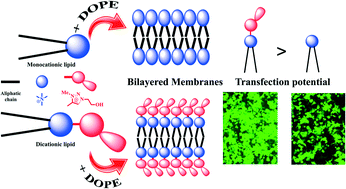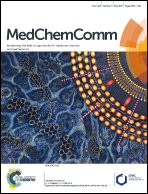Novel 1,2,3-triazolium-based dicationic amphiphiles synthesized using click-chemistry approach for efficient plasmid delivery†‡
Abstract
Herein, we report the synthesis, characterization and evaluation of the transfection efficiencies of a series of dicationic amphiphiles designed to construct quaternary ammonium ion-based cationic lipids varying in chain length of the hydrophobic back bone connected individually through head group to a 1,2,3-triazolium cation consisting of 2-hydroxy ethyl chain as substitution. Accordingly, three dicationic amphiphiles were synthesized by “click chemistry” approach and formulated to bilayered vesicles using DOPE as a co-lipid. The transfection efficacies of these novel lipid formulations were measured and correlated with the results obtained from various physicochemical techniques. Importantly, the observed gradient in the activity profile, where the transfection potential increased with decreasing chain length of the lipid hydrophobic back bone, highlights the synergistic interplay of the lipid alkyl chain length in coordination with charge delocalization in modulating the transfection potency of these 1,2,3-triazolium-based lipids.



 Please wait while we load your content...
Please wait while we load your content...